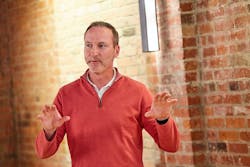Executive Insights With ISE EXPO Keynote Presenter, Scott Mispagel, Frontier Communications
Last year, I asked Veronica Bloodworth, Chief Network Officer, Frontier Communications, who she’d recommend as a standout keynote presenter for this year’s ISE EXPO. Without hesitation, she said Scott was the right fit. While I knew Scott just a bit, Veronica’s confidence in him was authentic.
I see why.
Scott's leadership reflects his values. He believes in timeless principles such as honesty, humility, and reliability. He is not afraid to admit when he doesn't have all the answers and consistently follows through on his commitments.
Be sure to join us at ISE EXPO to learn why his many years of field experience make him effective at helping transform Frontier’s network and how his creative strategies may help you do the same at your company.
When permitting is delayed, it affects the timeline, resources, and budget for fiber deployment. This ultimately impacts people's ability to access the best broadband connectivity available.
Topic: Network Expansion
ISE: Pure-play fiber deployment can be straightforward or frustrating. Can you give us insight into how Frontier tackles some of the challenges associated with it?
Scott Mispagel: We tackle some of the common challenges in a few key ways. First, we emphasize planning. Instead of just focusing on immediate tasks, we pre-design more markets. This approach helps align the supply chain, pre-plan labor, and provides flexibility in case of weather issues or permit delays.
Another essential strategy is lining up labor and materials in advance. Sharing long-term plans with vendors ensures better support for efficiency and throughput objectives, allowing vendors to be more effective partners over extended projects.
Permitting is another critical area where we take proactive steps. We start the permit process early to avoid unforeseen delays that could leave materials and labor stranded, risking future builds.
Finally, we standardize our design across different geographies. This simplifies the supply chain and operational training, ensuring consistency and reducing costs during installation or repairs. By not cutting corners, we maintain quality and avoid higher expenses down the line.
Topic: Copper to Fiber Network Transformation
ISE: Your 2023 YE report1 shares that total fiber passings were 6.5M and copper passings were 8.9M. The low-hanging fruit is the easiest to address when transforming the network from copper to pure-play fiber. Of course, the rest of the copper passings are more challenging. Share your roadmap and technological innovations to convert copper to fiber in 2024.
Mispagel: As one of the largest fiber builders in the U.S., we are working to move customers to fiber internet as soon as it is available in the market. Before installing fiber, we optimize the copper infrastructure to ensure it works as efficiently as possible. Then, as we build fiber into the market, we will educate customers about the benefits of fiber to help accelerate the transition from our copper networks.
Topic: AI and the Network
ISE: The AI Network Intelligence market is forecasted to grow 40% by 2029. By 2035, it could improve construction profitability by 71%. Many providers use AI to tame network complexity, reduce OpEx, and enhance network performance management. Share how Frontier is using AI now and how it will use AI across the network by about 2029.
Mispagel: AI can be transformative in our business when paired with the right talent.
At Frontier, nearly every team uses or experiments with AI to improve customer service and help us operate more efficiently. In the Network, we are using AI to drive operational efficiency from identifying potential issues before they impact a customer’s experience, to generating automated troubleshooting guides for field techs and performing call quality review and analysis for our call center agents, AI is strengthening our operations across the board.
Topic: Broadband Access
ISE: Please share more about Frontier’s efforts to ensure customers in underserved areas have the same access to high-speed fiber internet as their urban and suburban counterparts.
Mispagel: If we step back and think about the broader goal, it’s to build the critical digital infrastructure this country needs to thrive today and for future generations. That’s our purpose. We call it Building Gigabit America.
We are investing hundreds of millions of dollars toward achieving this goal and have one of the best—if not the best—teams for building fiber, so we are actively delivering the best product in the market to more homes and communities every single day.
As we build, we donate our high-speed, fiber internet to community-loved organizations impacting the areas we serve, from STEM education to programs for veterans and new moms. This helps ensure underserved community members have places to go where they can access the technology they need to connect to the digital world and all it offers.
Additionally, federal programs can be used to expand broadband access. BEAD is one of those programs, and we are actively participating in it and many others to build to the hardest-to-reach areas—the unserved and underserved—with subsidies that make the business case work.
Topic: Environmental Stewardship
ISE: A recent survey of 1,000+ IT leaders in 12 countries across the U.S., Europe, and Asia highlights growing concerns about the environmental impact of IT networks. One in five (20%) named “understanding the environmental impact of their IT infrastructure” as their top three priorities, and around the same (19%) named reducing the environmental impact of their IT infrastructure.
Please discuss the specific network initiatives Frontier is implementing this year to continue reducing its network impact.
Mispagel: Because fiber needs much less energy over a long distance than copper, there’s an overwhelming financial case for replacing legacy copper with fiber as quickly as possible. As we roll out more fiber, we carefully decommission copper, decreasing its negative environmental impact and minimizing costs while ensuring our customers stay connected.
Topic: 5G Private Networks
ISE: The U.S. Private 5G Network market is projected to grow 53% from 2022 to 2030, with customers demanding ultra-reliable, low-latency connectivity for their future bandwidth-sensitive applications. Broadband network providers are just one of the players in this market. What network-oriented upgrades must occur to ensure Frontier secures its share of this lucrative market?
Mispagel: Fiber backhaul is increasingly critical to support the data demands of wireless networks, including 5G. As one of the largest fiber builders in the country, our fiber infrastructure offers an attractive opportunity for providers to use this future-proof foundation for their wireless services. We already connect tens of thousands of cell towers with our fiber. As we continue to expand our fiber footprint, we are well-positioned to provide our partners with the best connectivity to support the growth of the 5G Network market.
Topic: The Elephant in the Room
ISE: What is our industry NOT addressing that it should in terms of network evolution and broadband for all?
Mispagel: Permitting. When permitting is delayed, it affects the timeline, resources, and budget for fiber deployment. This ultimately impacts people's ability to access the best broadband connectivity available. While work is being done in this area, we need to come together as an industry to address these challenges and implement solutions that will help deliver this critical infrastructure more efficiently to communities across the country.
Topic: Network Automation
ISE: What is Frontier doing to automate its networks, streamline network operations, reduce human errors, improve efficiency, and enable self-configuring and self-healing networks?
Mispagel: Today, our network's signaling and setup are automated. We also automate changes and fix issues automatically. But now, we're using machine learning to spot problems in real-time and fix them before they cause trouble.
Topic: Your Productivity Superpower
ISE: Given your workload, what is your superpower, and what do you wish it would be?
Mispagel: My superpower is my ability to build a highly skilled team that the business can rely on. We balance delegation and hands-on involvement at all levels to keep up with the hundreds of initiatives involved with turning a company around and building fiber at a leading scale. I am proud that my teams collaborate cross-functionally to work quickly and efficiently.
I wish I could connect with each team member on a deeper level. My schedule limits my ability to spend as much time with each person as I would like, but I know firsthand the impact it can have on a person—especially someone early in their career. My former boss and mentor, Bill Bellando, has the gift of making every interaction feel important and everyone feel heard and understood. That is a gift I will continue to work to develop.
Topic: Change Management and Culture
ISE: What have you learned about culture and change management that help your teams succeed with you as their leader?
Mispagel: The “why” behind the “what” is a powerful tool. Most people will follow a path if they understand why they are on it. While top-down mandates can be necessary, explaining the “why” helps bring people along and feel part of the change, not just on the first mile, but for the entire journey.
At Frontier, our “why” is clear and is transforming us from the inside out. Driven by our purpose, Building Gigabit America, we are delivering blazing-fast broadband connectivity to unlock the potential of millions of consumers and businesses. The “why” is backed by a clear fiber-first strategy that anyone in the company can articulate and can easily understand the role that they play within that. It has been clearly communicated and consistently executed, so I believe we have successfully implemented change at Frontier.
Topic: Leadership Style
ISE: Please share ONE word that encapsulates your leadership style. And ONE word that describes you as a person.
Mispagel: Respect. As a leader, I take care to create an environment where employees feel respected for the work they do and empowered to take initiative. When team members feel respected, they are more likely to lean in and help drive the business.
Versatile. I have been fortunate enough to have performed most of the jobs in my organization at one time or another, so I have the credibility and deep expertise I need to get to the root of an issue, find a solution, and clearly navigate a path forward.
REFERENCE
1. 2023 YE Report, https://s201.q4cdn.com/129601114/files/doc_financials/2023/q4/Frontier-Fourth-Quarter-2023-Trending-Schedule-pdf1.pdf
Scott Mispagel oversees all aspects of network technology engineering, operations, and service delivery while spearheading Frontier's nationwide fiber build. Joining Frontier in 2013 as VP of Network Engineering and Architecture, he quickly revolutionized Frontier’s network engineering practices and network standards to drive scale and efficiency. During that process, he built a team that is leading the industry by introducing new technologies and deployment practices. Scott also led Frontier’s network acquisitions and integration efforts, solidifying the company's position as a key player in the telecommunications landscape. www.frontier.com
About the Author
Sharon Vollman
Content Ambassador for ISE EXPO
Sharon Vollman is the Content Ambassador for ISE EXPO. She is passionate about collaborating with thought leaders, SMEs and hard-working doers who design, plan and deploy ultra-reliable broadband networks. Vollman is committed to creating a variety of educational offerings for ISE EXPO attendees that inspire them to connect every U.S. citizen with the broadband networks we all want for our children and grandchildren.
Vollman has created educational partnerships with Broadband Service Providers including AT&T, Verizon, Lumen, Frontier Communications and others. She has covered the telecom industry since 1996.




